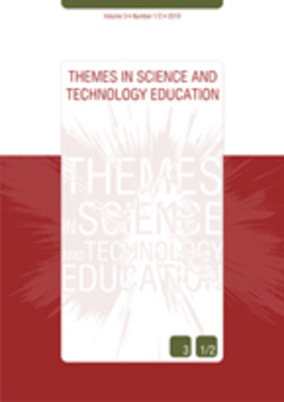School on Cloud : Towards a paradigm shift
Part of : Themes in science and technology education ; Vol.7, No.1, 2014, pages 47-62
Issue:
Pages:
47-62
Abstract:
This paper presents the basic concept of the EU Network School on Cloud: Namely, that present conditions require a new teaching and learning paradigm based on the integrated dimension of education, when considering the use of cloud computing. In other words, it is suggested that there is a need for an integrated approach which is simultaneously pedagogic (i.e. new role of teachers), technical/technological (i.e. use of the internet), administrative (i.e. new role of school administrators), social (i.e. a different disposition of parents towards school), political (i.e. a different approach of government to school) and cultural (i.e. new role of students), being in dialectic harmony and respecting all aspects of teaching and learning, an integral part of which are pupils, teachers and school administrators. As a result, the principal tasks in the area at the interface between education and cloud technology, which are presented in this paper, are to determine and describe the nature of the basic education stakeholders: i-Students, i-Teachers and i-Administrators.
Subject:
Subject (LC):
Keywords:
Cloud computing, education, paradigm, competences
Notes:
SoC: “School on Cloud: Connecting Education to the Cloud for Digital Citizenship” Project (Coordinator: Doukas School) has been funded with support from the European Commission: Lifelong Learning Program (ICT Key Action 3 European Project 543221-LLP-1-2013-1-GR-KA3-KA3NW).
References (1):
- Anderson, L. W., & Krathwohl, D. R. (2001). A taxonomy learning, teaching, and assessing: A revision of Bloom's taxonomy of educational objectives. New York: Longman Publishers. Beyond Current Horizons (2009). 6 Future scenarios. Beyond Current Horizons Programme, Futurelab, Retrieved 4 February 2014, from http://www.beyondcurrenthorizons.org.uk/scenarios. Brown, J. S., & Adler, R. P. (2008). Minds on fire: Open education, the long tail, and Learning 2.0. Educause Review, 43(1), 17-32. Conole, G. (2010). Facilitating new forms of discourse for learning and teaching: harnessing the power of Web 2.0 practices. Open Learning, 25(2), 141-151. Cruz, L. (2011). How Cloud Computing is Revolutionizing Education, Cisco Technology News. Dede, C. (2008). A seismic shift in epistemology. EDUCAUSE Review, 43(3), 80–81. Retrieved 4 February 2014, from http://net.educause.edu/ir/library/pdf/ERM0837.pdf.Donert, K. (2013). Lifelong learning Programme Application Form, KA3_MN_EL_SoC. Brussels: European Commission.Donert, K., & Bonanou, H. (2014). Education on the Cloud 2014: State of the Art. Retrieved 4 February 2014, from http://www.schoolonthecloud.eu.Drago-Severson, E. (2009). Leading adult learning development in our schools. Thousand Oaks, CA: Cornin/Sage Press.Ercan, T. (2010). Effective use of cloud computing in educational institutions. Procedia Social and Behavioral Sciences, 2(2), 938–942.European Communities (2007). Key Competences for Lifelong Learning. Luxembourg: Office for Official Publications of the European Communities.Fullan, M., & Langworthy, M. (2013). Towards a New End: New Pedagogies for Deep Learning, Retrieved 4 February 2014, from http://www.newpedagogies.info/wp-content/uploads/2014/01/New_Pedagogies_for_Deep Learning_Whitepaper.pdf.Gaytos, C. (2012). Education: Why cloud computing?. Cloudtweaks. Retrieved 4 February 2014, from http://www.cloudtweaks.com/2012/02/education-why-cloud-computing. Gialamas S., Pelonis P., & Medeirod, S. (2013). Metamorphosis: a collaborative leadership model to promote educational change, Thoughtful Mind. Institute for Innovation and Creativity, ACS, Athens. Retrieved 4 February 2014, from http://issuu.com/acsathens/docs/final_publicity_book_2012/23. Gutta, S. (2012). Education in the Cloud: How one school is revolutionizing the classroom. Boxblog. Retrieved 4 February 2014, from http://blog.box.com/2012/07/education-in-the-cloud-how-one-school-is-revolutionizing-the-classroom. Jimoyiannis, A., Tsiotakis, P., Roussinos, D., & Siorenta, A. (2013). Preparing teachers to integrate Web 2.0 in school practice: Toward a framework for Pedagogy 2.0. Australasian Journal of Educational Technology, 29(2), 248-267. Jonassen, D. H., Carr, C., & Yueh, H. P. (1998). Computers as Mindtools for engaging learners in critical thinking. TechTrends, 43(2), 24–32. Katz, R. N. (2008). The Gathering Cloud: Is this the end of the middle?. Educause, Retrieved 4 February 2014, from http://www.educause.edu/research-and-publications/books/tower-and-cloud/gathering-cloud-end-middle. Koutsopoulos, C. K. (2008). Teaching Geography: Instructing with GIS and about GIS. In K. Donert (ed.), GIS in Education (pp. 25-37). San Diego CA: ESRI Press.Kuhn, S. T. (1962). The structure of scientific revolutions. Chicago: University of Chicago Press. Lave, J., & Wenger, E. (1991). Situated learning: Legitimate peripheral participation. Cambridge: Cambridge University Press. McLaughlin, C., & Lee, M. J. W. (2010). Personalized and self-regulated learning in the Web 2.0 era: International exemplars of innovative pedagogy using social software. Australasian Journal of Educational Technology, 26(1), 28-43. Meier, J. D. (2011). The Gamification of Education. J.D. Meier’s blog. Retrieved 4 February 2014, from http://blogs.msdn.com/b/jmeier/archive/2013/02/27/the-gamification-of-education.aspx.Mell, P., & Grance, T. (2011). The NIST Definition of Cloud Computing. Gaithersburg, MD: National Institute of Standards and Technology, U.S. Department of Commerce.Nicholson, J. (2009). Cloud Computing’s Top Issues for Higher Education. University Business Solution for Higher Education Management. Retrieved 4 February 2014, from http://www.universitybusiness.com/viewarticle.aspx?articleid=1342&p=4#0. Northgate, D. (2012). Northgate Managed Services secures £170m contract to provide Education Cloud for Northern Ireland. Capita Managed IT Solutions, UK. Retrieved 4 February 2014, from http://www.capita-mits.co.uk/News/Northgate-Managed-Services-secures-%C2%A3170m-contract#sthash.VUigImlG.dpuf.Partnership for 21st Century Skills (2009). P21 framework definitions. Retrieved 4 February 2014, from http://www.p21.org/storage/documents/P21_Framework_Definitions.pdf.Pearlson, K. E., & Saunders, C. S. (2006). Managing and Using Information Systems: A Strategic Approach. NJ: John Willey & Sons (third edition).Pearsons, T. (2007). An Outline of the Social System. In C. Calhoun, J. Gertes, J. Moody, S. Pfaff & I. Virk (eds.), Classical Sociological Theory (pp. 421-440). Malden, MA: Blackwell Publishing. Prensky, M. (2001). Digital natives, digital immigrants. On the Horizon, 9(5), 1-6.Sheth, R. (2010). Movers and Shakers Interview. Frost & Sullivan's Unified Communications & Collaboration group. Retrieved 4 February 2014, fromhttp://www.frost.com/prod/servlet/market-insight-print.pag?docid=194716100. Siemens, G. (2003). Learning Ecology, Communities, and Networks extending the classroom. Retrieved 4 February 2014 from http://www.elearnspace.org/Articles/learning_communities.htm.Thomas, P. Y. (2009). Cloud Computing: A potential paradigm for practicing the scholarship of teaching and learning. Retrieved 4 February 2014, from http://www.ais.up.ac.za/digi/docs/thomas_paper.pdf.UTAS (undated). Welcome to the Western education system. University of Tanzania (UTAS) Information booklet. Retrieved 4 February 2014, from http://www.teaching-learning.utas.edu.au/__data/assets/word_doc/0015/1167/students_welcome.doc.Van den Brande, L., Carlberg, M., & Good, D. (2009). Learning, Innovation and ICT: Lessons learned from the ICT Cluster, Education and Training 2009 Programme. Brussels: European Commission.Wiles, J. (2007). Redesigning Schools-Redefining Education. DesignShare.Com. Retrieved 4 February 2014, from http://www.designshare.com/index.php/articles/redefining-education-full.




